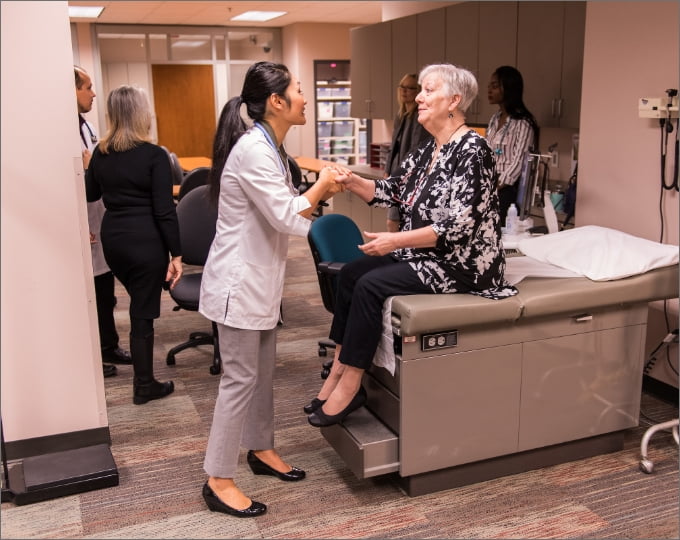
How Male Nursing Has Evolved and Why We Need More Male Nurse Practitioners
February 26, 2020Men have a long history in nursing, and now there are more male nurse practitioners and registered nurses than ever before. Still, when compared with women, men continue to be underrepresented.
Training more male nurses, through programs like Texas Woman's online Master of Science in Nursing – Family Nurse Practitioner, will balance representation in health care.

A Brief History of Men in Nursing
It's a common misconception that women have always dominated nursing. In reality, participation by men and women has fluctuated since the start of the profession.
Nurses were primarily male through the Middle Ages.
In ancient Egypt, men provided nursing care to the public and wounded soldiers. The first nursing school, which opened in 250 B.C. in India, was intended primarily for men.
In 330 A.D., Constantine the Great established the first hospitals. Men managed administration and patient care, while women were appointed to feed, comfort and nurse the female patients.
Eventually, religious and military orders began looking after the sick. The Alexian Brothers and Knights Hospitallers are examples.
By the Renaissance Era, the role of men in nursing began to decrease. Feudal warring and political infighting pulled men away from hospitals. As a result, more women took up nursing roles in the following centuries.
In the 19th century, hospitals hired men and women to render nursing care, but the quality of hospital-based nursing became wholly unreliable.
To recruit competent and trained nurses, hospitals established nursing schools to recruit competent and trained nurses, but few admitted men so nursing quickly became an occupation primarily for females.
Most men were excluded from nursing into the 20th century.
In 1901, the U.S. Army formed the Nurse Corps, which only commissioned women until 1955. However, contract male nurses did serve during the Spanish-American War and World War I.
In the second half of the century, collegiate programs replaced hospital nursing schools. Many still refused to admit men. This changed, however, in 1981 when the U.S. Supreme Court ruled nursing schools could not bar men from admission.
Since then, male enrollment in nursing programs has grown. The result is an increasing number of men in nursing.
Read more about the history of nursing.

How Many Male Nurse Practitioners Work in the U.S.?
The number of male nurses continues to rise. Between 2010 and 2018, the employment of male registered nurses nearly doubled. The employment of male nurse practitioners almost tripled.
Yet men are still underrepresented in nursing.
During the same eight-year period, the percentage of male registered nurses among full-time workers increased from 10.3% to 13.2%. But the proportion of male nurse practitioners grew just 2%, from 9.3% to 11.3% of the full-time workforce.
As of March 2019, the states that employed the fewest male nurse practitioners were Vermont, Delaware, North Dakota and Hawaii along with Washington, D.C. The highest number of male nurse practitioners were found in Florida, California, Texas, New York, and Tennessee.

Why Are Male Nurse Practitioners Underrepresented?
1. Cultural Stereotypes
In a 2005 study of men in nursing, 38% said more males aren't drawn to the profession because it's viewed as a female role.
The popular perception of nursing is that it's most appropriate for women. According to the Robert Wood Johnson Foundation (RWJF), a common idea of a nurse is “a white woman in a white dress and white cap.”
RWJF suggests the media over-emphasizes the “feminine” traits of nursing. In television shows, movies and commercials, nurses are often portrayed as nurturing caretakers.
According to the American Association of Colleges of Nursing, the majority of nurses are indeed female and white. Health care authorities agree the profession must prioritize the recruitment of underrepresented groups.
The role of a nurse extends far beyond caretaking and is vital to the health care team. Nurse practitioners, for example, are trained to provide many of the same primary, acute and specialty health care services as doctors.
As licensed, independent professionals, nurse practitioners are qualified to:
- Evaluate patients – Over half of nurse practitioners see at least three patients per hour
- Diagnose and treat acute and chronic conditions like diabetes and injuries
- Prescribe medication – Approximately 96% of nurse practitioners prescribe medications
- Work in numerous health care settings, including hospital outpatient centers, inpatient units, private practice and mental health facilities
Nurse practitioners are advanced practice registered nurses, which means they must hold graduate degrees. A program like Texas Woman's online Master of Science in Nursing – Family Nurse Practitioner equips nurse practitioners with the advanced clinical knowledge to become holistic primary care providers.
Nursing is designed for all individuals, regardless of gender or other demographic factors.

2. Lack of Male Role Models
A shortage of role models is another reason why the U.S. health care system lacks male nurse practitioners. Because just one in 10 nurse practitioners are male, aspiring male nurse practitioners can have difficulty finding a mentor.
Career role models are key to success. One study found that a role model can help build motivation, reinforce ambitions and establish new goals.
Mentors are essential for men considering a career in nursing. As an underrepresented group, aspiring male nurses can feel isolated. But role models can boost their confidence.
As the number of male nurse practitioners grows, so will the available mentors. In the meantime, it's crucial to recognize the extraordinary contributions of male nurses.
Edward Lyon, a nurse anesthetist, helped expand the role of men in military nursing by becoming the first male nurse commissioned in the U.S. Army Nurse Corps.
Another prominent figure is Luther Christman, who founded the American Association for Men in Nursing. He became a renowned advocate for male nursing after facing discrimination throughout his career.

3. Low Pay
Low pay is a reason why more men don't pursue nursing. However, low salary is a misconception, especially for nurse practitioners. On average, nurse practitioners in the U.S. earn $110,030 per year.
This is one of the highest salaries of all health care workers. Nurse practitioners earn 37% more than registered nurses and 21% more than physical therapists.
Salary, along with the job market and future employment growth, is why nurse practitioner is considered one of the nation's top jobs. U.S. News & World Report ranked it among the top five best jobs in health care, STEM and the country overall.
- Learn more about nurse practitioner salary.

Why Does the U.S. Need More Male Nurse Practitioners?
Demand for Primary Care Providers
There's a critical shortage of primary care providers. To fulfill the demand, the country needs more male nurse practitioners.
The population of aging adults is growing. By 2032, the number of adults over age 65 is projected to increase by 48%. At the same time, one-third of doctors will be over 65 years old. The result is an estimated deficit of 21,100 to 52,200 primary care physicians.
The American Association of Nurse Practitioners believes nurse practitioners can fill the gap.
Approximately nine in 10 are prepared in primary care. With a distinct blend of medical and nursing qualifications, nurse practitioners can provide high-quality, patient-centered services to a broad range of individuals.
But according to RWJF, men must be part of the solution. By becoming nurse practitioners, men can create stable and rewarding careers while helping the country meet critical health care demands.

Quality Improvement
More male nurse practitioners will also help improve the quality of patient care.
The National Academy of Medicine declared that positive patient outcomes depend on achieving greater diversity in nursing, particularly in terms of gender and race/ethnicity.
Why? Patients benefit from health care providers who represent a variety of backgrounds. Nearly half of Americans are men, but almost 90% of nurse practitioners are women.
By recruiting more male nurse practitioners, health care settings can offer an alternative for patients who desire a male health care provider.
Male nurse practitioners can also add new perspectives to health care teams, which can boost productivity.
A study on workplace diversity by the Massachusetts Institute of Technology showed that diverse teams function better. With differing skills and ideas, an organization can think more critically and make stronger decisions.

Male Interest in the Profession
More male nurse practitioners are needed to attract men into the profession. As more men join the workforce, others will feel more comfortable doing the same.
Male nurse practitioners can also boost interest in the occupation by:
- Identifying opportunities to serve as role models for men seeking a career in health care
- Correcting misconceptions about the job, such as duties and salary
- Counteracting misleading media portrayals by advocating for the actual role of nurses
Nursing organizations and academic institutions must also be involved in boosting male interest. Many say the recruitment of underrepresented nursing students is a crucial step.

Learn More about Becoming a Male Nurse Practitioner
Male nurse practitioners have a unique opportunity to advocate for the profession, improve patient care and address the primary care dilemma while inspiring the next generation of men in nursing.
As the eighth largest Family Nurse Practitioner (FNP) program in the nation, Texas Woman's University is a leading institution for health care professionals. It will prepare you to become a family primary care provider through a transformative experience that emphasizes patient well-being, professional behavior and clinical mastery.
As an online FNP student, you'll develop advanced health care knowledge, research skills and clinical capabilities. You'll also gain a multifaceted perspective when it comes to the wellness of patients, their families and communities.
Co-educational since 1994, Texas Woman's welcomes men and women and promotes diversity and collaboration as part of its culture of innovation, research and creative expression.
Learn more about Texas Woman's online FNP program.

